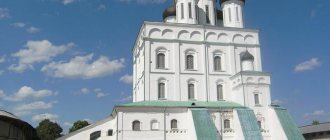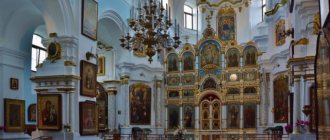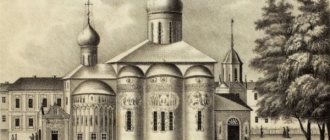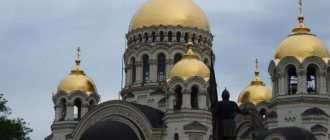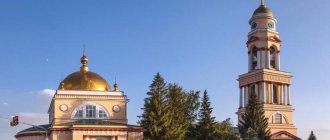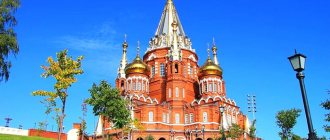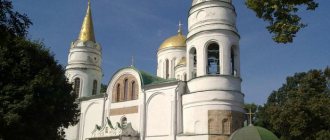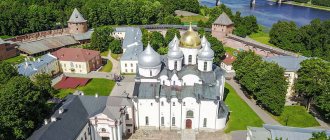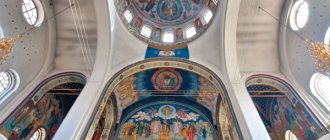In this article we will describe in detail the Holy Trinity Cathedral (Saratov). It is rightfully considered one of the key attractions of the Lower Volga region. Finding this architectural masterpiece of the Baroque Naryshkin period is not difficult. The cathedral stands on the high bank of the Volga, in the greenest district of Saratov, not far from the beautiful embankment and the world-famous bridge. Golden domes play in the sun, which in contrast with the blue of the sky makes them look like luminaries. The honeyed chime of bells flows far over the expanses of the river. This temple is visited not only by tourists. Due to the abundance of relics and icons, pilgrims from all over Russia flock here. Services continue to be held in the temple. What does an independent traveler need to know about this most important cathedral of the city? We will tell you everything about the oldest temple in the Lower Volga region in this article.
Location
Do you know that the Holy Trinity Cathedral (Saratov) has changed its address? And it’s not just that the street it’s on was renamed. No! He literally moved from one bank of the Volga to the other. And this happened at the end of the seventeenth century. How? The history of the cathedral is inextricably linked with the life of the city. Saratov, as you know, was built as a fortress by Moscow archers. They chose the wrong place for the defense structure. And already in the first flood we felt it. In addition, the gentle left bank of the Volga was accessible to attacks by enemies, who were countless in that turbulent age. Nevertheless, Saratov with its Holy Trinity wooden church patiently stood in such a strategically inconvenient place for almost a hundred years. When the city occupied a right-bank position, a similar temple was built there in 1674. It was consecrated by Metropolitan Parthenius, but this did not bring much protection to the building, because already in 1684 the wooden church burned to the ground along with a significant part of the city.
Museums in Saratov
Among the museums that are worth going to there are quite a large number of worthy ones, however, the most interesting, in my opinion, are the following: Chernyshevsky Museum (Chernyshevsky St., 142), Borisov-Musatov Museum-Estate (Volskaya St. 33), Fedin Museum (St. Chernyshevsky, 154). Each museum is equally unique and has its own advantages and features. The museums contain collections of works, manuscripts, and masterpieces of fine art. It would be wrong to advise any of them; try to visit each of them and you will see that there is something to admire and see.
Apartments for a day in Saratov
When talking about the sights, temples and cathedrals in Saratov , it would probably be wrong not to touch upon the issue of temporary residence. Saratov, like many other cities, is rich in all kinds of hotels and inns, but, like everywhere else, they have the same disadvantages, which makes no sense to list.
We offer a modern solution to the issue of temporary accommodation - our service is called renting an apartment for a day in Saratov. For an affordable price, you will be presented with an apartment that has absolutely everything you need for a comfortable stay. Use the Spiti service and appreciate the convenience of this type of service.
Holy Trinity Cathedral (Saratov): history
According to legend, the Moscow archers brought with them two miraculous icons: the Savior and Our Lady of Kazan. Two churches were built for them - first on the left bank, and then on the right. Both churches burned down in a fire in 1684. Archpriest Ignatius, left without a parish, began sending petitions to Metropolitan Savvaty of Terek and Astrakhan so that he would allow the construction of a temple “with the same name.” However, the bishop was mysteriously silent for five whole years. Probably the petitions were eventually supported by gifts, and in 1689 permission to build was obtained. At the same time, the Metropolitan pointed out some architectural details of the future temple. The Holy Trinity Cathedral (Saratov) was erected with funds from the townspeople. The expenditure of funds was closely monitored, so construction was carried out quickly. Already in 1695 the temple was ready. Archimandrite Joseph arrived from Astrakhan for the consecration of the cathedral. He appointed the first rector - Grigory Spiridonov.
New Cathedral
But the blessing of Archimandrite Joseph did not bring the expected results. In the fire that happened in May 1712, the Holy Trinity Cathedral completely burned down. Saratov looked like ashes. The city burned to the ground. From documents we only know that the former temple had a roof covered with “tatters and bast”, and there was a bell tower “on pillars”. But even then the cathedral was two-tiered. The lower one was consecrated in the name of the Dormition of the Mother of God, and the upper one in honor of the Holy Trinity. At the same time, the Saratov Cathedral became the first sacred building that was heated. The refectory on the lower tier housed a Dutch oven with tiles. Thus, in winter, services were held there, and in summer - in the unheated upper church. After the fire, both floors were lengthened and provided with parallel arches. An upper gallery and a bell tower were also added. In addition to its direct purpose, it served as a watchtower and fire tower.
Construction of a stone building
Well, we don’t know about the money, but the bishop gave his blessing, and even indicated what features the future cathedral should differ from its counterparts, many of which had been erected by that time in Holy Rus'. With the receipt of the metropolitan's charter, work in the city square began to boil, and the entire Orthodox Saratov took part in it. The Trinity Cathedral was built not only with public funds, that is, voluntary donations from the townspeople, but also with their own hands. It is known that all work that did not require special qualifications was carried out by the future parishioners themselves.
Upon completion of construction in 1659, Archimandrite Joseph was sent from Astrakhan, who examined the new cathedral with all rigor and at the same time consecrated both of its churches - the upper one, in the name of the Most Holy Trinity, and the lower one, in honor of the Dormition of the Blessed Virgin Mary. The acceptance certificate drawn up by the meticulous archimandrite has survived to this day. It lists in detail all the design features of the building, and most of all pays attention to the luxurious and very rare for provincial churches Dutch oven, installed on the ground floor and covered with “wonderful tiles.”
Moscow Baroque
The Holy Trinity Cathedral (Saratov) and its bell tower initially stood separately from each other. The temple was semicircular, ship-type, with an altar in the form of an apse. According to the layout, the building was an “octagon mounted on a quadrangle.” This form is often found in Russian church architecture. The squat, static and massive “four” is balanced by the “eight” directed into the sky. The rich decor and plasticity of forms classify the Saratov Holy Trinity Cathedral in the Moscow Baroque style. The bell tower was connected to the temple only after reconstruction in 1837. It also represented an octagon on a quadruple in its layout. The bell tower was crowned with an octagonal tent. This tower appears light and graceful thanks to the cross-shaped windows with equal rounded ends. In the twenties of the eighteenth century, the belfry, in addition to bells, also acquired chimes.
Sights of Saratov
Saratovskaya embankment
One of the symbols of Saratov is the embankment. Here you can admire both sunset and sunrise. The place is really beautiful, it is perfect at any time of the day. During the day you can walk along the largest bridge in Europe, which connects Saratov and Engels. The evening embankment looks even more breathtaking; after sunset, hundreds of lights are lit here, reflected in the water, they fill it with light even more, creating an unforgettable picture that you can admire forever.
Lipka Garden in Saratov
The Lipki Garden in Saratov is an equally significant object for the city and its residents. It is located in the city center, rich in greenery, paths and cozy places to relax; the garden always attracts thousands of people who want to relax and admire the pristine nature. There are many places for families to relax on the territory: playgrounds for children, basketball and football fields, a lot of attractions and carousels for every taste. All this and much more make the Saratov Lipki Garden a favorite place for citizens and guests of the city.
Nikitin Brothers Circus in Saratov
We can’t imagine Saratov without the Nikitin brothers’ circus! A wonderful local circus, a worthy place for a fun time. This circus is a stationary one, founded in 1873, it is one of the five best in the country. Vivid performances, exotic animals, rare predators and the skill of a close-knit troupe will make your holiday fun and unforgettable.
Forced reconstruction of the temple
The Holy Trinity Cathedral (Saratov) played a significant role in the life of the city. Peter the Great visited here with his wife Catherine I. Before setting off on the Persian campaign, they listened to a farewell sermon in the cathedral. And in seventy-four, Saratov was occupied by Pugachev’s troops. The cathedral suffered fires several times. From 1774 to 1781, services were held only in the lower church, since the upper floor was completely burned. And time took its toll. At the end of the eighteenth century, through cracks were discovered in the walls of the cathedral. The bishop ordered the dismantled building to be dismantled and a new church to be built in its place. But, according to Russian tradition, this order was ignored. Services continued until the authorities sealed the cathedral in 1795. It remained closed until 1800. But no work was carried out. In the end, a certain wealthy city dweller M. Ustinov, manager of a salt company, used his own funds to build buttresses to support the walls. To prevent the building from looking ugly, a covered gallery was erected above it. In the western part it was completed by a powerful two-story porch topped with a triangular pediment. During the same period, the roof was covered with roofing iron.
PORTAL CONTACTS
Trinity Cathedral is the most ancient temple of the Saratov Metropolis, a living monument of Russian culture and history, a spiritual symbol of our city.
For the first time in documents, the Trinity Cathedral in left-bank Saratov is mentioned in 1621. It can be assumed that the Trinity Cathedral of the second (left bank) Saratov was founded simultaneously with the fortress in 1615 (1) . After the transfer of Saratov in 1674 to the right bank of the Volga, on the only square of the new city, with the blessing of Metropolitan Parthenius, a wooden Trinity Cathedral was erected, which subsequently burned down (2) . In 1685, Metropolitan Savvaty allowed the renewal of the Trinity Cathedral and issued a charter for the temple, after which the temple was rebuilt again in the form of a wooden structure. In 1694, Archpriest Ignatius Danilov and the cathedral clergy turned to Metropolitan Savvaty with a request for permission to collect “all sorts of supplies” for the construction of a stone two-story Trinity Cathedral, and Bishop Savvaty gave his blessing for this (3) . It should be noted that Tsar Peter 1, in response to the petition of the cathedral archpriest Danilov, in 1696 donated the Trinity Church with land, and by his decree the chapel outside the Moscow Gate was assigned to the Trinity Church. Income from the land, land and two chapels made it possible to raise funds for the construction of the stone Trinity Cathedral, which replaced the wooden one. In 1697, Archpriest Ignatius Danilov and the cathedral clergy addressed the newly installed Metropolitan of Astrakhan Sampson with a request for permission to begin construction of a stone cathedral. The Metropolitan gives his blessing, and in the same year the foundation of the cathedral is laid and rebuilt. In 1698, construction of the lower Assumption Church was completed. The cathedral was completely completed no earlier than 1701 and no later than 1710 (4) .
Thus, the Saratov Trinity Cathedral is the only architectural monument of Saratov at the turn of the 17th–18th centuries. and the only surviving temple in the Saratov Metropolitanate, built in the Moscow Baroque style.
The name of the architect of the Trinity Cathedral remains unknown.
During the 18th century, the architecture of the cathedral underwent significant changes, which made its appearance unique. Two significant reconstructions were carried out - the addition of a late (2nd) refectory to the western side of the cathedral and the “Ustinov” reconstruction, after which the temple as a whole acquired the appearance in which it exists to this day. To understand what the cathedral originally looked like, you need to mentally remove the second, later added, refectory and covered gallery, then we will have a typical, tiered, upward-sloping monument of the Moscow, or Naryshkin, Baroque style: the altar part, an octagon on a quadrangle, refectory. This style was distinguished by its magnificent festive decor and characteristic two-color, which was also embodied in the appearance of the Trinity Cathedral. However, the cathedral has a hipped bell tower, which cannot be attributed exclusively to the Naryshkin style. The tented form of the bell tower of the Trinity Cathedral is an original Russian form, developed by wooden Russian architecture. It is not possible to establish the exact time of its construction today. There is reason to assert that only the lower part of the bell tower, the quadrangle, was built simultaneously with the cathedral (5).
The later refectory was added to the cathedral, presumably in the 50-60s. XVIII century (6) .
The cathedral, along with the city, repeatedly suffered from fires. The fire of 1774 had the most devastating consequences for the temple - cracks appeared in its walls. It is noteworthy that a few years after the fire of 1774, by order of Catherine II, 81 rubles were kept in the Astrakhan provincial chancellery from the “property taken from the rebels (Pugachevites)”. 91/2 kopecks, half the amount was allocated for the “correction” of the cathedral that burned in Saratov. In 1786, Metropolitan Anthony of Astrakhan sent a letter ordering the temple to be dismantled due to its disrepair and a new one to be built. But Saratov residents then only temporarily closed the temple, which was especially beloved by the townspeople. The cracks were observed by a special committee of honorary parishioners. In particular, it included famous merchants M.A. Ustinov, G.Ya. Volkov and I.M. Pulkin. In 1798 – 1799 At the expense of Mikhail Andriyanovich Ustinov, buttresses were placed under the walls of the cathedral, strengthening the building, and a covered gallery was erected above them (due to which the cathedral lost part of its decor); on the western side, above the gallery, a two-story porch was built, which was crowned with a triangular pediment.
The reconstruction of the temple significantly changed its original appearance, the cathedral lost part of its external decor and the dynamics inherent in this architectural style, but acquired a bright individuality, and its silhouette began to look more like a ship - the “ark of salvation.”
Since the Trinity Cathedral was a cathedral, it was there that manifestos were read and the decrees of the Synod and Senate were proclaimed. The cathedral was visited by many visiting historical figures, as well as royalty.
It is precisely known that Emperor Peter I visited the Trinity Cathedral in June 1722, during his Persian (or Caspian) campaign in Transcaucasia. The royal caravan sailing along the Volga stopped in Saratov for a meeting with the Kalmyk Khan Ayuka, the ruler and lord of the Kalmyk tribes that roamed the area between the Volga and the Urals. The entry in the “Marching Journal” about Peter I’s stay in Saratov reads: “in the morning, His Majesty was with the local manager, from there he was in the cathedral church at mass” (Marching Journal 1722, St. Petersburg, 1855) (7) . In 1809, Emperor Alexander I “most graciously granted” a new “christened” sacristy to the Saratov Trinity Cathedral, which consisted of several expensive vestments and created “a lot of noise in the city, for he had never seen such a happy incident in his life!” - this is how Archpriest N. Skopin, who served at the Trinity Cathedral, tells about this event in his diary (8). In 1863, the temple was visited by the heir to the All-Russian throne, Grand Duke Nikolai Alexandrovich, brother of the future Emperor Alexander III. In order to familiarize the future emperor with the country, in July 1863 the crown prince and his retinue traveled along the Volga. The Grand Duke celebrated the Liturgy in the cathedral and venerated the especially revered icon of the Savior Not Made by Hands. In June 1913, Saratov was visited by Grand Duchesses Maria Alexandrovna (daughter of Emperor Alexander II) and Maria Pavlovna, widow of Grand Duke Vladimir Alexandrovich, third son of Alexander II, president of the Imperial Academy of Arts. The chronicle of the “Saratov leaflet” for June 1913 tells about the magnificent meeting of the royal persons and their visit to the “old cathedral”.
Saratov hosted the Tsarevich Alexander Nikolaevich (the future Emperor Alexander II), and the future Emperor Alexander III and his wife. However, not all royalty visited the Trinity Cathedral during their visits to Saratov, since since 1826 it ceased to be a cathedral. The guests were greeted by the “new” cathedral - the Holy Blessed Prince Alexander Nevsky. An interesting fact is that already in “perestroika” times, the Saratov Trinity Cathedral again hosted representatives of the House of Romanov. Until 1992, the dynastic head of the Romanov family was Grand Duke Vladimir Kirillovich (great-grandson of Alexander II, 1917–1992). In the year of the 380th anniversary of the House of Romanov, Saratov was visited by the wife of Grand Duke Leonid Georgievich, his only daughter Maria Vladimirovna, who inherited the position of head of the dynasty, and her son and heir, Grand Duke Georgy Mikhailovich, who came from France. Accompanied by Archbishop of Saratov and Volsky Pimen (Khmelevsky), the distinguished guests visited the Trinity Cathedral.
In the 20th century, the cathedral survived miraculously. On September 13, 1934, the verdict was pronounced on the Holy Trinity Cathedral - the presidium of the Saratov City Council decided: “In view of the mismanagement of the church, the destruction of the brickwork of the walls, fences and the presence of cracks in the arches of the columns, the failure to fulfill the obligation to carry out repairs - the contract with the collective of believers is terminated and the church is transferred Regional Museum for scientific purposes." During 1934, the community of believers tried to protest this decision. They contacted the regional prosecutor's office, the regional executive committee, wrote to the Holy Synod, Metropolitan Sergius and even to the office of the chairman of the All-Russian Central Executive Committee M.I. Kalinina. The pressure on the Orthodox community of the Holy Trinity Cathedral was so strong that in 1935 the “collective of believers” asked the city council to terminate the contract with them, because they did not have the means to pay the rent and building taxes due from them, “due to the fact that they had not had a service in the church since July 1934.”
On February 20, 1936, the Presidium of the All-Russian Central Executive Committee made the final decision to close the cathedral.
On February 20, 1936, the cathedral became the property of the state, which transferred the requisitioned building to the Regional Museum. It was this owner who actually saved the oldest temple in the Volga region from destruction by adapting the temple building into a storage facility. In 1942, during the “densification”, the GAU NKVD of the USSR (Main Archive Directorate of the NKVD of the USSR) was also located in the cathedral. The planned location in 1939 of an independent museum of the History of Religion and Atheism in the cathedral did not take place. In the difficult year 1942 for the country and the city, the cathedral again became a spiritual support for parishioners and one of the centers for collecting material funds for soldiers fighting Nazi Germany. The preparation of the “old” cathedral for the opening, the staffing of the clergy and the parish “twenty”, as well as the appointment of the rector were carried out by Archbishop Andrei (Komarov) of Saratov. By the decision of the executive committee of the Saratov City Council of Working People's Deputies on October 3, 1942, the Holy Trinity Cathedral was transferred to the community of believers for rental use.
Three days later - October 6 - the rector of the church, Hieromonk Boris (Vic, the future Bishop of Saratov and Volsky), appointed by Archbishop Andrei, signed an agreement on the transfer of the cathedral for rental use with the regional department of public education represented by the director of the Regional Museum of Local History M.A. Golubeva.
Already on the evening of October 7, the feast of St. Sergius of Radonezh, the first service took place in the church. On October 8, at the morning Liturgy, Father Boris (Vic) preached his first sermon. And on the same day, an agreement was signed between “a group of believers, including 20 people.” and Deputy Chairman of the City Council Andrei Frolovich Zheleznyakov on the transfer of the cathedral to “a group of believers of the Orthodox faith for indefinite free use.” At this time, the cathedral again became a cathedral, because the “new” cathedral was already destroyed.
Finally, by decision of the Arbitration Court of the Saratov Region, the cathedral was transferred to the ownership of the parish in September 2004. Until the 50s. of the last century, Trinity Cathedral was not painted. On June 22, 1949, the Holy Trinity Cathedral was visited by His Holiness Patriarch of Moscow and All Rus' Alexy I, who was traveling along the Volga. After examining the temple, he gave his blessing to repair it and paint the walls of the cathedral. The rector of the cathedral, Archpriest John Tsvetkov, recruited a team of icon painters from Palekh to paint the frescoes. The paintings were made in both churches of the Trinity Cathedral.
From 1972 to 1976, under the leadership of the Leningrad architect D. E. Babenkov, the domes of the cathedral were covered with copper and gilded.
In 1988, the entire Orthodox people solemnly celebrated the 1000th anniversary of the Baptism of Rus'. The main celebrations on this occasion in the Saratov diocese took place within the walls of the Trinity Cathedral. This anniversary year, the temple was visited by numerous foreign delegations.
The Holy Trinity Cathedral preserves the memory of many generations of believers who offered prayers there, asking for the mercy and intercession of the Lord in difficult days, of which there were many in the history of Russia. The cathedral was the place of service for many archpastors and pastors, some of whom were canonized as saints. Saint Innocent, Bishop of Penza and Saratov, visited Saratov shortly before his death. He performed his last divine service in the Holy Trinity Cathedral. Bishop of Saratov and Tsaritsyn Hermogenes (Dolganev), on whose initiative the “Construction Committee for the Repair and Decoration of the Trinity Cathedral” was created at the beginning of the 20th century, and the rector of the church, Archpriest Gennady Makhrovsky, ended their service to the Church with the feat of martyrdom. In the lower, Assumption, church of the Trinity Cathedral, a particle of the relics of the holy martyr Hermogenes (Dolganev), transferred to Saratov from the Tobolsk diocese, is kept. 62-year-old Honored Archpriest Gennady Makhrovsky, who served in the Trinity Cathedral for 37 years, having spent almost two months in a concentration camp, was shot on September 30, 1919 as part of the “Red Terror” declared by the Cheka. Father Gennady was buried in a common grave at the Resurrection Cemetery in Saratov.
Other well-known and beloved rulers of Saratov also served in the cathedral, including the first bishop of the Saratov diocese, newly established in 1799, Gaius Takaov, Bishop (later Archbishop) Jacob (Vecherkov), Bishop Veniamin (Milov), Archbishop (then Metropolitan) Grigory (Chukov) , Bishop (later Metropolitan) Boris (Vik), Metropolitan Veniamin (Fedchenkov), Archbishop Pimen (Khmelevskoy).
In June 1993, His Holiness Patriarch Alexy II of Moscow and All Rus' visited the Saratov diocese. For the first time in the history of the city, the Primate of the Russian Orthodox Church performed a divine service in Saratov, and it took place in the Holy Trinity Cathedral.
At the turn of the 20th–21st centuries. The cathedral was again in dire need of repair. Since the late 1990s. Serious work began to strengthen the foundation of the cathedral and the bell tower, which by that time had acquired a dangerous slope. In March 2001, due to the emergency condition of the Trinity Cathedral, the status of the cathedral was temporarily transferred to the Saratov Holy Spiritual Church. In the 2000s. The largest reconstruction in the history of the Trinity Cathedral was carried out. The initiator and organizer of the process of restoration, or rather, salvation of the Saratov shrine was His Eminence Longin, Bishop (now Metropolitan) of Saratov and Volsky. The lower, Assumption, temple was restored during the work of 2004–2007, and was consecrated on December 10, 2006. All work on the restoration of the Assumption Church was carried out under the leadership of the rector of the Holy Trinity Cathedral, Abbot Pachomius (Bruskov), now His Eminence Pachomius, Bishop of the Intercession and Nicholas. In October 2014, the restoration of the upper church of the Trinity Cathedral was completely completed. All work was carried out with high quality, professionalism and conscientiousness by a team of builders and restorers under the leadership of M.D. Pound. During the restoration work, it was not possible to preserve the former Palekh paintings of the cathedral, because The plaster layer was completely removed from the walls, damaged brickwork was repaired, vaults were strengthened in problem areas and new ceilings were installed, a new heating and ventilation system was installed, and lost iron connections were installed. However, the continuity of the stylistic design of the temple interiors was preserved. The new paintings of the cathedral were carried out by masters of the Palekh icon-painting workshop “Lik” under the direction of O.R. Shurkus.
On October 24–25, 2014, during his primate visit to Saratov, His Holiness Patriarch Kirill of Moscow and All Rus', at the end of the Great Consecration of the Seminary Church, announced a decree on returning the status of a cathedral to the Holy Trinity Church in Saratov. On the same day, His Holiness Patriarch Kirill, with Metropolitan Longinus and Bishop Pachomius, visited and inspected the Trinity Cathedral. His Holiness the Patriarch donated to the temple the image of the Intercession of the Most Holy Theotokos and the tabernacle.
On November 2, 2014, Metropolitan Longin of Saratov and Volsk with a council of clergy performed the rite of the Great Consecration of the upper church of the Trinity Cathedral and the first Divine Liturgy after the consecration. New paintings in the upper, Trinity, church of the cathedral were also made by masters of the Palekh icon-painting workshop “Lik”.
Currently, the cathedral clergy, choristers and all parishioners strive to ensure that the Holy Trinity Cathedral retains its significance as the center of church tradition. Here are ancient icons, many of which are not only sacred, but also of historical and cultural value. The Icon of the Savior Not Made by Hands is the most ancient revered shrine of the Saratov Metropolis. In the cathedral there are revered icons of the Mother of God “Kazan”, the Old Testament Trinity, images of Saints Theodosius of Chernigov and Innocent of Moscow with particles of holy relics. In January 2004, an icon of St. Seraphim of Sarov with fragments of his clothing was found in the cathedral. In January 2005, a ceremonial transfer to the Saratov diocese took place of a shrine that had been kept for many years in the Saratov Museum of Local History: a unique reliquary that contains 132 pieces of relics of saints. It is kept in the lower church of the Trinity Cathedral. The cathedral also contains several icons brought from Mount Athos in the 19th century. These are the icons of the Mother of God “Quick to Hear”, “Seeking the Lost”, the image of the Holy Great Martyr Panteleimon. In 2010, the Iveron Icon of the Mother of God was delivered to the Holy Trinity Cathedral, specially painted and consecrated on Holy Mount Athos by order of the parishioners of the cathedral - a copy of the same icon, which over its more than thousand-year history has become famous throughout the world for many miracles.
To preserve and study church antiquities and historical information about clergy, parishioners and the events of the centuries-old history of the cathedral, the first church museum in the Saratov Metropolis was created in 2012.
In 2012, on the territory of the Holy Trinity Cathedral, the construction of a new administrative building was completed, which houses a Sunday school, an educational center, and administrative and economic services.
So, at the turn of the third millennium, Saratov residents again preserved and restored their old cathedral; prayers are still offered in it to God, in the Trinity of the Consubstantial One; the cathedral still serves people and is an adornment of our city.
(1) Belikov M.P. Old Cathedral and Old Town: History of the Holy Trinity Cathedral and the city of Saratov in the light of new data. - Saratov, 2015. P. 24.
(2) Ibid. P. 110.
(3) Ibid. P. 190.
(4) Ibid. P. 277.
(5) Ibid. P. 309.
(6) Ibid. P. 332.
(7) See: Maksimov E.K., Mezin S.A. Cities of the Saratov Volga region of Peter the Great's time. St. Petersburg, 2010. P. 162.
(8) See: Skopin N., prot. Daily notes about deeds and memorable things // Saratov historical collection. T. 1. Saratov, 1891. P. 378.
October Revolution and new government
After all the reconstruction, they decided to make the temple an ordinary parish church dedicated to Alexander Nevsky. The status of the cathedral was returned to it by the suffragan bishop Hermogenes (Dolganev). At the beginning of the twentieth century, he began a grandiose reconstruction and expansion of the temple. But the renovation work was not destined to end. The October revolution was greeted by Saratov residents without much enthusiasm. Moreover, in 1919, repressions against the clergy began. Bishop German, the rector of the church Gennady Makhrovsky and other priests were shot. The Holy Trinity Cathedral (Saratov), the photo of which, fortunately, has been preserved, was stolen. In an atheistic frenzy, they wanted to demolish it, but the public insisted on preserving the historical building. In 1934, the funds of the local history museum were housed within its walls. At the beginning of the Patriotic War, the authorities sent new clergy to Saratov. Services in the temple resumed in 1942. But after the war, the cathedral fell into disrepair again. Only in 2006 did a large-scale reconstruction of the temple take place.
Construction of the chapel
The chapel was built much later than the cathedral - in 1895 under the supervision of architect S.P. Kondratieva. Its construction was timed to coincide with two miraculous events in the royal family - during the Borki train tragedy in 1888 and in 1891 during the trip of the future Emperor Nicholas II to Japan.
The chapel is made in the same style as the cathedral - neoclassical, white stone walls and a sky-blue dome with stars. Inside there is a Royal iconostasis and several large icons.
The building did not always remain untouched: during the years of Soviet power, the chapel housed a cafe, and during and after the Second World War - a warehouse.
Holy Trinity Cathedral (Saratov): description of the Assumption (lower) Church
This tier has been completely replaced. The building's plinths were removed from under the cultural layer. New communications were also installed and the floors were replaced. The paintings of the mid-twentieth century, which have no artistic or historical value, were completely cleared from the walls. A team of icon painters from Palekh was invited to create new frescoes. The temple was painted by masters based on surviving old photographs, trying to adhere to the style of the eighteenth century as much as possible. The iconostasis of the Assumption Church was recreated in the same way. The restorers paid a lot of attention to the walls of the building. The counterforms were repaired and the brickwork was partially replaced. The temple was re-consecrated in December 2006.
Description of the upper tier
Restoration work here lasted much longer. It was necessary to put the “octagon” in order, as well as the covered gallery above the buttresses, the domes and the bell tower. The work was completely completed only in 2014. The upper temple was, as before, consecrated in honor of the Life-Giving Trinity. Here, as in the lower tier, the iconostasis was completely replaced, and the walls were painted. All small architectural details of the interior were re-done. Patriarch Kirill came to the Holy Trinity Cathedral (Saratov) for the consecration. This was during the Primate's visit. After the service, Kirill issued a patriarchal decree. In it, he returned the temple to the status of the cathedral of Saratov. But now it is officially called “The Descent of the Holy Spirit.” There are two churches inside the cathedral. The upper one bears the former name of the temple - Holy Trinity, while the lower one is called Assumption.
Architecture
Trinity Cathedral was built in the spirit of the Naryshkin Baroque style. This is a ship-like structure: semicircular, with an altar ledge. In the center is the Octagon, rushing upward, as if leading the quadrangle, the luxury and grace of the view grows with height.
Over the course of several years, the facades were completely restored and its historical appearance was restored. The details of the temple decoration were redesigned: frames, crossbars, and the domes were gilded. A new color composition was introduced, the roof and the protruding sides of the front facade of the crossbars and buttresses of the cathedral were replaced with copper material. The gallery patterns were completely replaced, the mosaic flooring was restored and a new fence was built.
The best article for you, go to: Transfiguration Cathedral Nizhny Novgorod
The interior was overhauled for three years and expanded by deepening the floor. The images from the sixties of the twentieth century were of no value and were removed. The icon painters of the Palekh workshop painted the walls. The paintings on the vaults, walls, and window openings, made in the spirit of the seventeenth century, made it possible to bring the building closer to the architectural style and give the cathedral indescribable beauty.
Choir
The main reason why many people come from afar to visit the Holy Trinity Cathedral (Saratov) is Christmas services. The choir of this temple is famous far beyond the region. Even after the October Revolution, the traditions of church Orthodox singing were not forgotten, but were carefully preserved and developed. Despite troubles at work, many Saratov musicians considered it their Christian duty to sing in the cathedral choir. Now there are several singing groups in the temple: an amateur one (male and female) and two professional ones. One performs the choir on weekdays, and the second only on church holidays. Even atheists come to the cathedral to listen to this last one. The choir consists of thirty people. All singers have higher musical education. The choir often performs on tour in other cities of Russia and abroad. But on holidays he always returns to the Holy Trinity Cathedral (Saratov). Christmas and Easter services on the occasion of the Dormition of the Mother of God and the Descent of the Holy Spirit are held under their mellifluous singing.
Current state
Restored inside and out, the Trinity Cathedral is now a spiritual shrine, under the care of which is the entire city.
Social work of churched Christians led by priests includes:
- teaching Sunday school to children and adults;
- the opportunity to participate in an amateur choir;
- providing charitable assistance to the needy and sick;
- bell ringer training classes.
All interested Christians can join the volunteer effort; a museum is open here.
Temple shrines
Not only tourists and music lovers are attracted to the Saratov Cathedral. According to legend, the city was founded by Moscow archers. The soldiers brought with them a banner with the image of the Savior. This oriflamme once led the archers into battle. Later, the canvas was pasted onto a board and hidden under a gilded silver frame. Another shrine of the cathedral is the miraculous icon of Our Lady of Kazan. No less revered are the relics of Seraphim of Sarov and Theodosius of Chernigov. Many paintings are of artistic value. This is the miraculous face of the Iveron and August Mother of God, the “Quick to Hear”, the Trinity, Panteleimon and the “Seeking of the Lost”.
Description of the interior of the cathedral
The main supporting objects inside the temple are Corinthian columns. They are topped with white marble to match the overall design of the cathedral. The central dome is distinguished by its high vault. The walls and ceilings are decorated with paintings by artists T.A. Medvedev and A.I. Travina. The semicircular iconostasis is also decorated with columns.
The cathedral has a military past, so its walls were decorated with trophies brought from the Russian-Turkish war. Marble plaques with the names of heroes who distinguished themselves in battle have been preserved. The temple has an unspoken second name - “Bulgarian”. It is believed that it was built with money from grateful liberated Bulgarian residents.
Not long ago, the cathedral acquired new elements of decoration: images of Saints Peter and Paul and Nicholas the Wonderworker, made in mosaics.
Reviews about the temple
What do travelers say about the Holy Trinity Cathedral? Saratov, reviews of which are mostly positive, is famous primarily for this church, built in the Moscow Baroque style. For a believer, this is the House of God. Parishioners and pilgrims come here to worship numerous shrines. But people who are far from believing in the other world will also be interested in looking at the icons of Christ the Savior and Our Lady of Kazan - they are of historical and cultural value. Around the cathedral there is a beautiful garden with rose bushes and a pond in which goldfish swim.
Photos
If you would like to enjoy the indescribable beauty of the Trinity Cathedral, but do not yet have the opportunity to visit the shrine in person, we have prepared a selection of photographs especially for this occasion.
